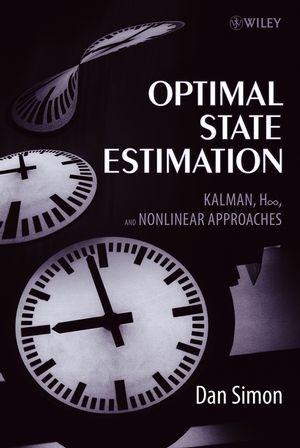|
Textbook
Optimal State Estimation: Kalman, H Infinity, and Nonlinear ApproachesISBN: 978-0-471-70858-2
Hardcover
552 pages
June 2006, ©2006
 This is a Print-on-Demand title. It will be printed specifically to fill your order. Please allow an additional 10-15 days delivery time. The book is not returnable.
|
||||||
Acronyms.
List of algorithms.
Introduction.
PART I INTRODUCTORY MATERIAL.
1 Linear systems theory.
1.1 Matrix algebra and matrix calculus.
1.1.1 Matrix algebra.
1.1.2 The matrix inversion lemma.
1.1.3 Matrix calculus.
1.1.4 The history of matrices.
1.2 Linear systems.
1.3 Nonlinear systems.
1.4 Discretization.
1.5 Simulation.
1.5.1 Rectangular integration.
1.5.2 Trapezoidal integration.
1.5.3 RungeKutta integration.
1.6 Stability.
1.6.1 Continuous-time systems.
1.6.2 Discretetime systems.
1.7 Controllability and observability.
1.7.1 Controllability.
1.7.2 Observability.
1.7.3 Stabilizability and detectability.
1.8 Summary.
Problems.
Probability theory.
2.1 Probability.
2.2 Random variables.
2.3 Transformations of random variables.
2.4 Multiple random variables.
2.4.1 Statistical independence.
2.4.2 Multivariate statistics.
2.5 Stochastic Processes.
2.6 White noise and colored noise.
2.7 Simulating correlated noise.
2.8 Summary.
Problems.
3 Least squares estimation.
3.1 Estimation of a constant.
3.2 Weighted least squares estimation.
3.3 Recursive least squares estimation.
3.3.1 Alternate estimator forms.
3.3.2 Curve fitting.
3.4 Wiener filtering.
3.4.1 Parametric filter optimization.
3.4.2 General filter optimization.
3.4.3 Noncausal filter optimization.
3.4.4 Causal filter optimization.
3.4.5 Comparison.
3.5 Summary.
Problems.
4 Propagation of states and covariances.
4.1 Discretetime systems.
4.2 Sampled-data systems.
4.3 Continuous-time systems.
4.4 Summary.
Problems.
PART II THE KALMAN FILTER.
5 The discrete-time Kalman filter.
5.1 Derivation of the discrete-time Kalman filter.
5.2 Kalman filter properties.
5.3 One-step Kalman filter equations.
5.4 Alternate propagation of covariance.
5.4.1 Multiple state systems.
5.4.2 Scalar systems.
5.5 Divergence issues.
5.6 Summary.
Problems.
6 Alternate Kalman filter formulations.
6.1 Sequential Kalman filtering.
6.2 Information filtering.
6.3 Square root filtering.
6.3.1 Condition number.
6.3.2 The square root time-update equation.
6.3.3 Potter's square root measurement-update equation.
6.3.4 Square root measurement update via triangularization.
6.3.5 Algorithms for orthogonal transformations.
6.4 U-D filtering.
6.4.1 U-D filtering: The measurement-update equation.
6.4.2 U-D filtering: The time-update equation.
6.5 Summary.
Problems.
7 Kalman filter generalizations.
7.1 Correlated process and measurement noise.
7.2 Colored process and measurement noise.
7.2.1 Colored process noise.
7.2.2 Colored measurement noise: State augmentation.
7.2.3 Colored measurement noise: Measurement differencing.
7.3 Steady-state filtering.
7.3.1 a-P filtering.
7.3.2 a-P-y filtering.
7.3.3 A Hamiltonian approach to steady-state filtering.
7.4 Kalman filtering with fading memory.
7.5 Constrained Kalman filtering.
7.5.1 Model reduction.
7.5.2 Perfect measurements.
7.5.3 Projection approaches.
7.5.4 A pdf truncation approach.
7.6 Summary.
Problems.
8 The continuous-time Kalman filter.
8.1 Discrete-time and continuous-time white noise.
8.1.1 Process noise.
8.1.2 Measurement noise.
8.1.3 Discretized simulation of noisy continuous-time systems.
8.2 Derivation of the continuous-time Kalman filter.
8.3 Alternate solutions to the Riccati equation.
8.3.1 The transition matrix approach.
8.3.2 The Chandrasekhar algorithm.
8.3.3 The square root filter.
8.4 Generalizations of the continuous-time filter.
8.4.1 Correlated process and measurement noise.
8.4.2 Colored measurement noise
8.5 The steady-state continuous-time Kalman filter
8.5.1 The algebraic Riccati equation.
8.5.2 The Wiener filter is a Kalman filter.
8.5.3 Duality.
8.6 Summary.
Problems.
9 Optimal smoothing.
9.1 An alternate form for the Kalman filter.
9.2 Fixed-point smoothing.
9.2.1 Estimation improvement due to smoothing.
9.2.2 Smoothing constant states.
9.3 Fixed-lag smoothing.
9.4 Fixed-interval smoothing.
9.4.1 Forward-backward smoothing.
9.4.2 RTS smoothing.
9.5 Summary.
Problems.
10 Additional topics in Kalman filtering.
10.1 Verifying Kalman filter performance.
10.2 Multiple-model estimation.
10.3 Reduced-order Kalman filtering.
10.3.1 Anderson's approach to reduced-order filtering.
10.3.2 The reduced-order Schmidt-Kalman filter.
10.4 Robust Kalman filtering.
10.5 Delayed measurements and synchronization errors.
10.5.1 A statistical derivation of the Kalman filter.
10.5.2 Kalman filtering with delayed measurements.
10.6 Summary.
Problems.
PART III THE H, FILTER.
11 The H, filter.
11.1 Introduction.
11.1.1 An alternate form for the Kalman filter.
11.1.2 Kalman filter limitations.
11.2 Constrained optimization.
11.2.1 Static constrained optimization.
11.2.2 Inequality constraints.
11.2.3 Dynamic constrained optimization.
11.3 A game theory approach to H, filtering.
11.3.1 Stationarity with respect to xo and wk.
11.3.2 Stationarity with respect to 2 and y.
11.3.3 A comparison of the Kalman and H, filters.
11.3.4 Steady-state H, filtering.
11.3.5 The transfer function bound of the H, filter.
11.4 The continuous-time H, filter.
11.5 Transfer function approaches.
11.6 Summary.
Problems.
12 Additional topics in H, filtering.
12.1 Mixed KalmanIH, filtering.
12.2 Robust Kalman/H, filtering.
12.3 Constrained H, filtering.
12.4 Summary.
Problems.
PART IV NONLINEAR FILTERS.
13 Nonlinear Kalman filtering.
13.1 The linearized Kalman filter.
13.2 The extended Kalman filter.
13.2.1 The continuous-time extended Kalman filter.
13.2.2 The hybrid extended Kalman filter.
13.2.3 The discrete-time extended Kalman filter.
13.3 Higher-order approaches.
13.3.1 The iterated extended Kalman filter.
13.3.2 The second-order extended Kalman filter.
13.3.3 Other approaches.
13.4 Parameter estimation.
13.5 Summary.
Problems.
14 The unscented Kalman filter.
14.1 Means and covariances of nonlinear transformations.
14.1.1 The mean of a nonlinear transformation.
14.1.2 The covariance of a nonlinear transformation.
14.2 Unscented transformations.
14.2.1 Mean approximation.
14.2.2 Covariance approximation.
14.3 Unscented Kalman filtering.
14.4 Other unscented transformations.
14.4.1 General unscented transformations.
14.4.2 The simplex unscented transformation.
14.4.3 The spherical unscented transformation.
14.5 Summary.
Problems.
15 The particle filter.
15.1 Bayesian state estimation.
15.2 Particle filtering.
15.3 Implementation issues.
15.3.1 Sample impoverishment.
15.3.2 Particle filtering combined with other filters.
15.4 Summary.
Problems.
Appendix A: Historical perspectives.
Appendix B: Other books on Kalman filtering.
Appendix C: State estimation and the meaning of life.
References.
Index.



